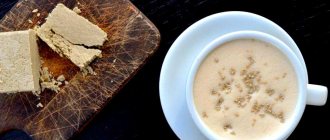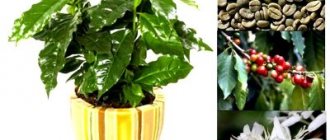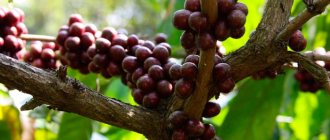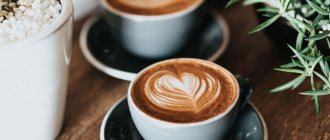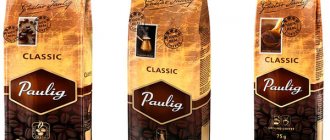What is Arabica
The designation on the can—Arabica coffee—is involuntarily associated with the name of the drink. However, this is not quite true. What is Arabica? In fact, it is a type of coffee tree, from the beans of which many types of coffee are produced. But we are more accustomed to calling all variations on the theme of this drink this way. The tree blooms with white flowers that open in the axils of the leaves. They say that the flowering period is an incredible beauty. But no one really saw it. It is impossible to catch flowering, because after 2 days everything falls off and fruits begin to set. This takes 9 months. The green color of the fruit gradually gives way to red. The pulp becomes juicy. Many local inhabitants of the animal world love to feast on the fruits of the coffee tree.
That's another thing
Arabica, or Arabian coffee tree, is a typical “inhabitant” of tropical countries.
And, nevertheless, the capricious plant cannot tolerate tropical heat, and prefers to hide from it in the light coolness of the mountains.
The highland plantations of Brazil and the countries of Latin America, India and Indonesia are the areas of world Arabica production. There are no frosts here - the average daily temperature ranges from 15 to 24C, and the mineral-rich soil is annually “irrigated” by seasonal rains.
The natural height of wild Arabica coffee is ≈ 6-8 m; however, for ease of harvesting, breeders “stopped” its growth when it reached 4m.
After each rainy season, the tree transforms: its dark green foliage reveals white, fragrant inflorescences reminiscent of jasmine flowers.
8-9 months after flowering, the fruit ripens - a dark red, almost spherical berry. One tree can have both flowers and fruits at the same time, so the harvest is harvested only by hand, so as not to damage the unripe berries.
Inside each ripe berry there are grains - paired, greenish-gray, elongated, one side of which is “divided” by a longitudinal wavy groove.
The coffee bean is the “container” of chemical components and substances that form the excellent taste of the contents of the coffee cup. Thus, the main components of the Arabica flavor “set” are caffeine (1.2-1.3%) and aromatic oils (≈18%).
Coffea Arabica is not very productive. The annual fruit harvest does not exceed 5 kg. From them only 1 kg of coffee beans is obtained.
Arabica coffee tree
The evergreen tree of the madder family is called Coffea Arabica. The plant reaches 10 meters in height in its natural environment. But it is not allowed to grow to such a state, otherwise harvesting the fruits will be labor-intensive and time-consuming, which will not affect the cost of the finished product for the better.
How did Arabica appear? Africa is the birthplace of the coffee tree and Arabica coffee. The shepherd was the first to notice the effect of the red berries. Goats that ate them were characterized by increased activity and endurance. The shepherd shared his observation with the abbot of the monastery. Thus, coffee berries became the diet of monks during long hours of prayer.
The appearance of the coffee tree is associated with cross-pollination of the small Eugenioides bush with Robusta, which already existed at that time. The small tree with the lowest caffeine content, Eugenioides, has many similarities to other coffee trees in terms of growth and fruit ripening. Therefore, it became the parent of a new species.
Budget coffees
Here is a list of the best budget bean coffees.
- Paulig Classic is good for its foil packaging, which allows you to preserve its aroma and taste for a long time. Medium roast, rich aroma with nutty notes. Grinds quite easily.
- Lavazza Tierra Selection Its raw materials are grown in Peru, Honduras and Colombia. The degree of roasting is medium, the taste is pronounced and dense.
- Bushido Red Katana Grown in East Africa, packed in Switzerland. Roasting is manual. Cools off in the clean alpine air.
- Julius Meinl Espresso Premium Collection Blend suitable for making espresso.
- Movenpick Caffe Crema Contains a minimum of caffeine, so you can drink it several times a day.
Where did Arabica originate?
Geographically, the Arabica tree appeared in territories that historically belonged to Kenya, Sudan and Ethiopia. But the Ethiopians were the first to eat fruits in raw and boiled form. As trade relations with the Arabian Peninsula developed, coffee trees began to be grown there. In turn, the Arab world discovered the coffee drink thanks to the inhabitants of Arabia, so it began to be called Arabian. This is not entirely correct, since Africa is the ancestor. But centuries later it is difficult to change anything. Therefore, the second name of the drink is still used in everyday life - Arabian coffee.
Exotic coffees
They are already more difficult to find on sale.
- Black Ivory The processing process is very similar to Kopi Luwak, but fermentation is carried out by elephants.
- Coffee Saint Helena Unusual in that it grows on Saint Helena Island, which is not part of the Earth's Coffee Belt. It has a unique taste with notes of orange and caramel.
- Kona Coffee Unusual in that it grows in Hawaii
- Blue Bourbon Good with strong acidity and an unusual taste of spices.
Places of growth
If we consider in general the climatic and natural conditions favorable for the coffee tree, then most often these are places located at an altitude of 500-2500 meters above sea level. Favorable temperature for fruit ripening is 15-24°C. Each tree bears fruit for 50 years. This process is especially abundant during the first 15 years. In the mountains, the harvest is harvested once throughout the year, in the valleys - up to four times. A maximum of 5 kg of fruit can be collected from each tree. These yield only 1 kg of coffee beans.
Regions that gave us the taste of the best coffee
America
- Chocolate flavor of Brazilian coffee Santos.
- Grape, blackberry with a pleasant sweet sourness from Costa Rica.
- Notes of watermelon or cherry with a nutty aftertaste - this is a drink from Honduras.
- Mexican coffee is associated with fruit.
Africa
Coffee from the African continent is characterized by a medium to high density drink with weak acidity and an intense bitter or sweet taste. A distinctive feature of the countries of origin is the aftertaste. The drink from Zambia is characterized by caramel notes. For Rwanda - nuts, Yemen - wine, Kenya - citrus, Tanzania - spicy, Congo - tobacco.
Asia
Asian coffee is distinguished by its high density and strength. Local residents of India, Yemen, Saudi Arabia, Indonesia, and Vietnam prefer exclusively strong types of coffee. It is considered a man's drink and is combined with hookah smoking. Therefore, Asian manufacturers produce a drink that has notes of a herbal mixture, a creamy taste with moderate sourness.
Types of elite coffees
These can cost a lot, however, they can be found on the open market. Here are the elite varieties that you should definitely try.
- Kopi Luwak . The price of one of the most expensive types of drink is due to the unusual method of its production. The variety comes from Indonesia, where an animal called the luwak or civet lives, which eats grains. In the stomach and intestines of Luwak, they undergo a unique fermentation, which enriches the taste of the drink.
- Kenya AA Ruiruiru . It has a multi-layered aroma. At first it is caramel and sweetish, then cherry-chocolate. The taste has notes of orange.
- Galapagos . The trees are grown without chemicals. It has a mild bitterness and a nutty aroma.
- Jamaica Blue Mountain . It has a delicate and delicate taste without bitterness. The taste includes cherry, licorice, vanilla, and chocolate. Aftertaste with a hint of hazelnuts and caramel. The grains are supplied in a wooden barrel.
- Island of Java . The grains are artificially aged.
Arabica beans
We offer a small life hack for choosing grains by appearance. You should not follow the original Russian rule in this matter - the more, the better. Large sizes do not indicate the quality of the product. It is necessary to choose oblong, oval-shaped grains. This is the typical format of the legendary Arabica grown. It can be very diverse in size - from small to huge.
Grain composition
- Caffeine - 1-1.5%
- Essential oils – 18%
- Sugar - 8%.
After roasting, the color of the beans remains absolutely even over the entire surface due to their elongated size. This is an important difference between Arabica and Robusta, which does not demonstrate uniform shade.
Rating of the best types of coffee
Ratings for the grain version of the drink are updated regularly. In 2020 , consumers and experts ranked the following types as leaders:
- Lavazza Leader in quality, different types of roasting.
- Paulig Good with a pleasant aftertaste and bright aroma.
- Jardin Real Arabica, large selection of countries and varieties.
- Julius Meinl The grains are ideal in size, shape, rich taste, excellent quality.
- Carraro South American coffee.
How to select and store coffee beans
It is recommended to pour the beans from the original packaging into an airtight container with a lid. The container can be made of wood, glass, ceramics, metal. Natural materials do not negatively affect the quality of the product.
The main secret is that each variety is stored separately, even if you mix them during the cooking process. When storing different types together, the individual smell is lost, which leads to an incomprehensible taste of the drink.
Store jars on shelves with lockable doors. This way you protect from direct sun rays, waterlogging, and food odors. Do not place the jar on the shelf next to dried fruits, seasonings, or scented candles.
Family ties
In addition to Arabica, there are also three main types of coffee on the coffee market. All of them are united by certain “family ties”, from which geneticists, to please the consumer, shape the taste of the drink.
About 30% of the world's coffee exports belong to robusta, or Coffea Canephora. The drink made from its beans, rich in caffeine and chlorogenic acids, is less aromatic and very strong, with a persistent bitter aftertaste. Canephora is usually mixed with other types of coffee beans - then its bitter, earthy taste is softened, and the coffee produces a high, stable crema.
The official discovery of the Congolese “relative” took place only 2 centuries ago. However, geneticists have established that in the process of natural crossing of the rough Robusta, unpretentious in cultivation, rich in caffeine (up to 2.5%) with the now rare species Eugenioides, a refined, “sweet-tasting” Arabica coffee appeared, the beans of which have half the amount of invigorating bitter alkaloid.
Liberica and Excelsa also have similar taste qualities to Robusta. Due to the low quality and unstable ripening of the fruits, the latter types of coffee have no direct economic significance.
The owner of a strong aroma - liberica - has found its use mainly in the confectionery industry. The drink made from its grains has a weak, unsaturated taste.
Excelsa is used as an “intensifier” of the taste and aroma characteristics of elite quality coffee.
But the main thing is that it can be used to “graft” other tree varieties. With the participation of Excelsa, the most famous varieties of Arabica were obtained - mocha, bourbon, typica, Colombian Arabica, etc. It is worth getting to know these and other varieties of Arabica better.
Five Factors Affecting the Taste of Arabica
Natural
The yield, taste, and quality of coffee depend on typical climatic conditions. These are air temperature, amount of precipitation and intensity of exposure to sunlight. Manufacturers have learned to influence the quality of mail using fertilizers and fertilizing.
Principle of fruit collection
The main slogan of an honest producer is that we collect only ripe berries. But for this it is necessary to motivate the pickers - the harvesters, who are the poorest segments of the population. For this purpose, guest workers are even invited, to whom the principle of work is explained. The collected fruits are sorted, so it’s easier to do your job efficiently from the beginning.
Treatment
The choice of bean processing method directly affects the taste and aroma of the finished coffee.
Genetic mutation
Mutation of coffee plants can be natural or artificial when a grower plants trees for crossbreeding in hopes of producing a variety of flavors.
Liberica
The taste of Liberica is characterized by increased bitterness and a sharp taste, which makes it a low-quality product. This variety is used only as part of a mixture, most often in order to reduce the cost of production. The aroma of Liberica is reminiscent of the notes of Arabica, but the taste cannot be compared with it.
The homeland of this plant is Liberia, which is located on the African continent. The tree is unpretentious, therefore, with proper care, it can be grown anywhere where there is a suitable climate. The coffee beans of this variety are larger than Arabica beans.
Liberica is used, in addition to mixtures, for the production of instant coffee and in the confectionery industry.
Conclusion
The more we delve into the topic - what Arabica coffee is, the more clear it becomes, how much we still don’t know, the history of the drink of the gods is so multifaceted. To summarize, we can say the following.
- The birthplace of the drink is Ethiopia.
- Collecting, processing and roasting is a lot of painstaking work for many people.
- It is better to try coffee varieties produced in different countries to choose the one that suits your taste.
- Instant coffee is not the generally accepted “drink of the gods” with an amazing taste, despite the fact that Arabica is also added to it.
- Arabica is a type of coffee bean with many varieties.
- The best roast is traditionally considered medium, but we do not limit your choice and do not impose our taste.
Please note that the inscription on the label 100% Arabica means nothing. This is not a guarantee of quality or great taste. You need to go a long way, try different varieties, to understand for yourself which one is really number one.
Finally, a few recommendations
- The question arises: if Arabica coffee varieties are sold in their pure form, why not Robusta as a single variety? Experts say that Robusta is so cheap that after drinking a cup of coffee from it, you will be surprised why this swill is called a divine drink. To save costs, it was decided to mix Arabica and Robusta coffee varieties with each other and with the addition of other types.
- You should try blends of Arabica beans first; if you don’t have enough strength in your drink, try adding a small amount of Robusta. You can also experiment by mixing Arabica, Robusta, and Mocha coffee varieties.
- In the classic combination, Arabica and Robusta varieties are mixed in a ratio of 82:18. If the packaging says that there is more than 18% robusta, this means that the manufacturer was greedy and saved money. Saving on the Arabica variety leads to a deterioration in the taste of the drink. The maximum permissible percentage of robusta should not exceed 20 percent.
Features of cultivation
This type of coffee tree is unpretentious, but the best yield is achieved in mountain valleys, where high humidity and temperature remain throughout the year. Under such conditions, it is possible to obtain up to 4 grain harvests per year. In addition, the chemical composition of the soil suitable for this plant has a positive effect on fruiting.
The flavor of the beans varies depending on which region they come from. When grown on poor soils in arid conditions, where a short-term temperature drop below 15°C is possible, it is possible to obtain a harvest once a year. On average, one tree produces from 2 to 5 kg of berries.
Nowadays coffee is grown on extensive plantations. Gentle hillsides are often cultivated for this tree. The plant requires systematic pruning to prevent excessive branch spread. The berries are picked manually.
How does it grow?
This type of coffee tree is quite capricious. He needs special conditions
- Scattered rays of the sun.
- Constant flow of fresh warm air.
- Regular but moderate supply of moisture.
- Special soil composition, with a balance of organic and mineral substances.
Due to the burning direct rays of the sun in South and Central America, the plant is planted under the canopy of local trees. Tall and spreading neighbors scatter the hot rays and cover capricious coffee trees from gusts of wind and heavy rainfall.
